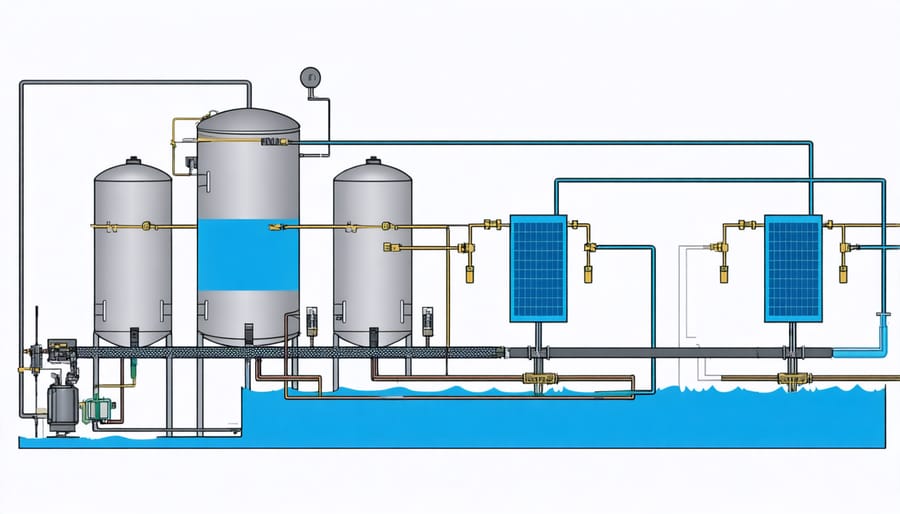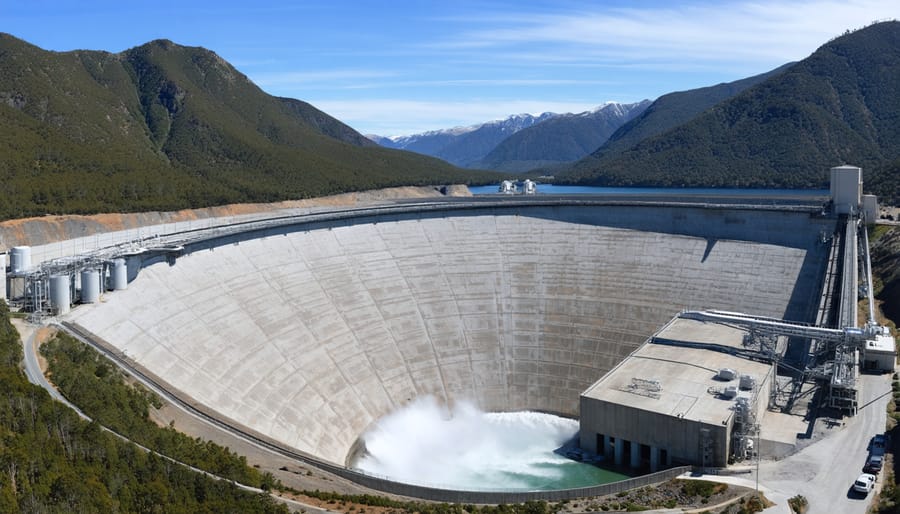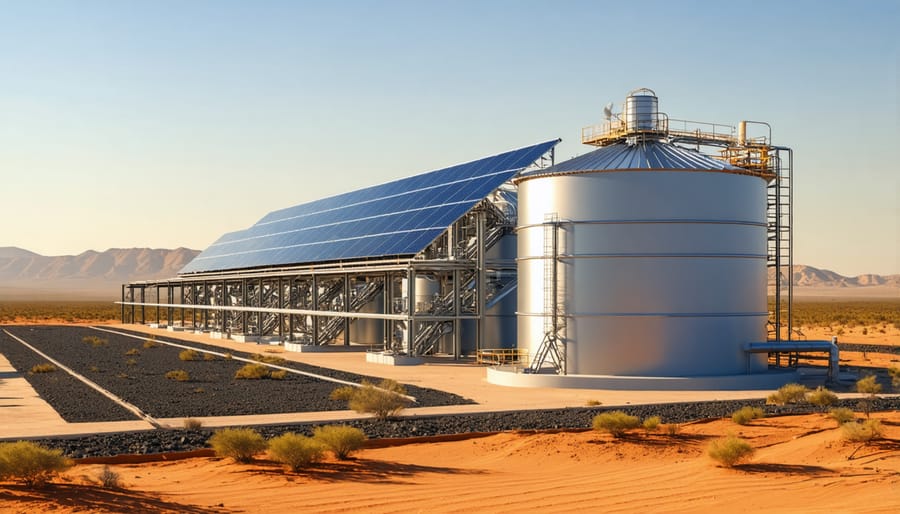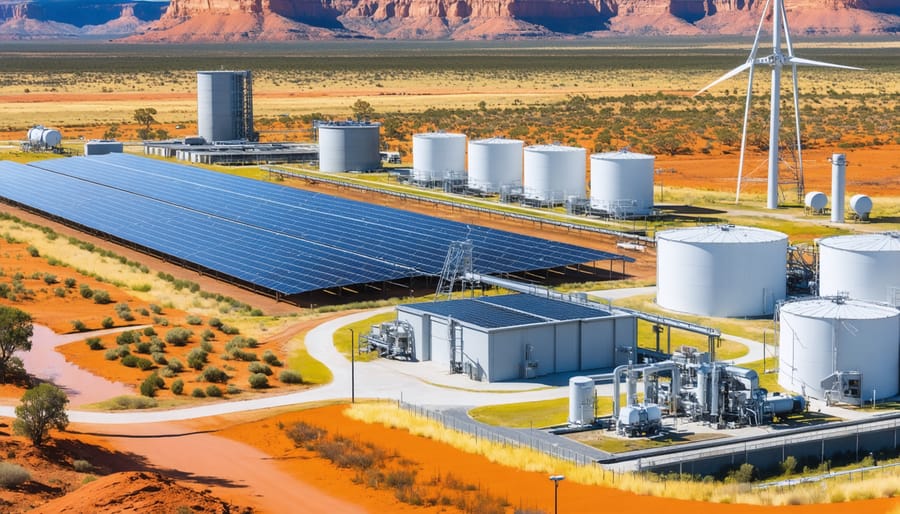Energy storage stands at the forefront of Australia’s renewable energy transition, transforming how we capture, store, and utilize power across the continent. From massive pumped hydro facilities in the Snowy Mountains to neighborhood battery systems in suburban Perth, storage technologies are revolutionizing our ability to harness renewable resources effectively. These solutions bridge the gap between intermittent energy generation and consistent power demands, creating a more resilient and sustainable grid network.
Modern energy storage encompasses far more than traditional batteries. It includes thermal storage systems that capture heat in molten salt, kinetic solutions that store energy in spinning flywheels, and chemical storage methods that convert surplus electricity into hydrogen fuel. Each technology offers unique advantages, adapting to different environmental conditions, scale requirements, and energy needs across Australia’s diverse landscape.
As our nation accelerates towards a clean energy future, understanding these storage options becomes crucial for businesses, communities, and policymakers. These technologies not only support grid stability but also enable energy independence, reduce costs, and create new opportunities for economic growth in regional areas.
Chemical Energy Storage: Beyond Traditional Batteries
Advanced Battery Technologies
The landscape of energy storage is rapidly evolving, with lithium-ion innovations leading the charge in advanced battery technologies. These developments have dramatically improved storage capacity and efficiency, making renewable energy more viable than ever for Australian homes and businesses.
Flow batteries are emerging as game-changers in large-scale storage applications. Unlike traditional batteries, these systems store energy in liquid electrolytes, allowing for easy scaling by simply increasing tank size. This makes them particularly suitable for storing solar and wind energy in Australia’s remote communities, where reliable power storage is essential.
Solid-state batteries represent the next frontier in storage technology. These batteries use solid electrolytes instead of liquid ones, offering increased safety and energy density. While still in development, Australian researchers are at the forefront of making these batteries commercially viable, with promising results in laboratory testing.
Recent breakthroughs include advanced thermal management systems that help batteries perform better in our harsh climate, and new electrode materials that significantly extend battery life. These innovations are particularly relevant for our growing renewable energy sector, where reliable storage is crucial for maintaining consistent power supply during peak demand periods.
The integration of smart battery management systems has also improved efficiency and longevity, making these technologies increasingly cost-effective for both residential and industrial applications.

Hydrogen Storage Systems
Hydrogen storage represents one of Australia’s most promising energy storage solutions, offering a clean and versatile way to store renewable energy for extended periods. By using excess solar and wind power to split water into hydrogen and oxygen through electrolysis, we can create a renewable energy carrier that’s both powerful and sustainable.
Australian industries are particularly well-positioned to benefit from hydrogen storage systems. Our abundant solar resources and vast open spaces make us ideal candidates for large-scale hydrogen production and storage facilities. Several pilot projects across the country are already demonstrating how hydrogen can be stored in various forms – from pressurized tanks to underground caverns.
What makes hydrogen storage particularly attractive is its flexibility. The stored hydrogen can power fuel cells for vehicles, generate electricity through turbines, or serve as a feedstock for industrial processes. Major mining companies in Western Australia are leading the charge, implementing hydrogen storage solutions to power their heavy machinery and reduce their carbon footprint.
The technology also addresses one of renewable energy’s biggest challenges: seasonal storage. While batteries typically store energy for days or weeks, hydrogen can be stored for months without significant losses, making it perfect for managing Australia’s seasonal energy demands.
Despite current storage infrastructure costs, ongoing technological improvements and increasing scale are making hydrogen storage more economically viable each year, positioning it as a cornerstone of Australia’s renewable energy future.
Mechanical Energy Storage Solutions
Pumped Hydro Storage
Pumped hydro storage stands as Australia’s powerhouse of renewable energy storage, accounting for over 90% of the nation’s large-scale storage capacity. The iconic Snowy Hydro pumped storage facility leads the charge, demonstrating how we can harness gravity and water to store massive amounts of energy.
The concept is brilliantly simple: during periods of excess power generation, water is pumped uphill to a higher reservoir. When energy is needed, the water flows back down through turbines, generating electricity like a conventional hydroelectric plant. It’s like having a giant rechargeable battery made of water!
Recent developments across the country are expanding our pumped hydro capabilities. Tasmania’s Battery of the Nation initiative and Queensland’s Kidston Pumped Storage Hydro Project are setting new benchmarks for clean energy storage. These projects not only provide reliable backup power but also help stabilize the grid as we integrate more solar and wind energy.
What makes pumped hydro particularly attractive for Australia is its long operational life – facilities can run effectively for 50-100 years with proper maintenance. Plus, unlike chemical batteries, pumped hydro systems don’t degrade over time and can store energy for extended periods without significant losses.
The future looks promising as new projects combine pumped hydro with other renewable technologies, creating hybrid systems that maximize our natural resources while supporting our transition to clean energy.

Compressed Air and Flywheel Systems
Compressed air and flywheel systems represent two innovative mechanical approaches to energy storage that are gaining significant momentum in Australia’s renewable energy landscape. These technologies offer unique advantages for specific applications, particularly in industrial settings and grid stabilisation.
Compressed Air Energy Storage (CAES) works by using excess electricity to compress air into underground caverns or specially designed tanks. When energy is needed, the compressed air is released through turbines to generate electricity. Several Australian mining operations are exploring CAES as a solution for their remote power needs, with the added benefit of utilising existing underground spaces.
Flywheels, on the other hand, store energy in the form of rotational momentum. These systems spin a rotor at incredibly high speeds in a low-friction environment, effectively acting as mechanical batteries. The stored energy can be rapidly converted back to electricity when required, making flywheels particularly valuable for power quality management and frequency regulation.
What makes these technologies especially appealing is their long operational life and minimal environmental impact. Unlike chemical batteries, they don’t require rare earth materials and have virtually no toxic components. Several Australian universities are currently developing advanced flywheel designs using carbon fibre composites, promising even higher energy density and improved efficiency.
Both systems are proving particularly valuable in supporting renewable energy integration, helping to smooth out the intermittent nature of wind and solar power while providing reliable backup power for critical infrastructure.
Thermal Energy Storage
Molten Salt Storage
Molten salt storage represents a game-changing advancement in solar thermal storage applications, particularly for Australia’s sun-drenched regions. This innovative system uses specially formulated salts that can maintain temperatures above 500°C, making it ideal for storing vast amounts of thermal energy from solar installations.
The process is beautifully simple: during daylight hours, the salt mixture is heated by concentrated solar energy, transforming from a solid to a liquid state. This molten salt is then stored in well-insulated tanks, where it retains its heat with remarkable efficiency. When power is needed, especially after sunset, the stored heat is used to generate steam, which drives conventional turbines to produce electricity.
What makes this technology particularly exciting for Australia is its proven reliability and cost-effectiveness. The Crescent Dunes Solar Energy Project, while not in Australia, demonstrates how this technology can provide up to 10 hours of full-power electricity storage, showing tremendous potential for our sunny continent. Several Australian energy providers are now exploring this technology to enhance our renewable energy capabilities and ensure round-the-clock power supply.

Phase Change Materials
Phase change materials (PCMs) represent an innovative breakthrough in thermal energy storage, offering a clever way to capture and release heat energy through the natural process of materials changing state. Think of how an ice pack stays cold – PCMs work on a similar principle but at various temperatures suited for different applications.
In Australian homes and businesses, PCMs are making waves in building design and temperature control. When integrated into walls or ceiling materials, they absorb excess heat during hot summer days and release it when temperatures drop, creating a natural cooling effect. This passive temperature regulation can significantly reduce air conditioning costs and energy consumption.
The technology has found particular success in solar thermal applications, where PCMs store daytime solar energy for evening use. For instance, some innovative Australian greenhouse projects use PCMs to maintain optimal growing temperatures overnight without additional energy input.
Recent developments include bio-based PCMs derived from sustainable sources, aligning perfectly with environmental goals. These materials can store up to 14 times more heat per unit volume than conventional materials like water, making them an increasingly attractive option for energy-efficient building design and industrial processes.
Bioenergy Storage Integration
Biomass as Energy Storage
Nature has perfected energy storage over millions of years through biomass, and we’re increasingly harnessing this remarkable capability. Biomass energy storage involves capturing solar energy in organic materials like wood, agricultural residues, and dedicated energy crops, which can be used when needed.
In Australia, biomass storage solutions are gaining traction, particularly in rural areas where agricultural waste is abundant. Sugar cane bagasse in Queensland, for instance, serves as a brilliant example of biomass storage in action. The fibrous residue from sugar production is stored and later burned to generate electricity, providing a reliable energy source during crushing season and beyond.
What makes biomass particularly valuable as an energy storage medium is its versatility and stability. Unlike some renewable energy sources, biomass can be stored for extended periods without degradation, making it an excellent backup power solution. From wood pellets to biogas derived from organic waste, these materials effectively act as batteries charged by the sun through photosynthesis.
The beauty of biomass storage lies in its circular nature. Energy-rich materials that might otherwise go to waste – like forestry residues, food processing waste, and livestock manure – become valuable energy resources. For example, several Australian farms are now using anaerobic digesters to store and convert agricultural waste into biogas, providing a steady power supply while reducing waste and emissions.
As we continue to develop more sophisticated storage technologies, biomass remains a practical, proven solution that complements other renewable energy systems, particularly in rural and agricultural settings where biomass resources are readily available.
Hybrid Storage Systems
Combining different storage technologies creates powerful synergies that maximize the benefits of each system while minimizing their individual limitations. Hybrid storage systems are particularly valuable in the Australian context, where diverse geographical conditions and energy needs demand flexible solutions.
A prime example is the integration of bioenergy with battery storage systems. When biogas plants are paired with advanced batteries, they can provide both steady baseload power and rapid response capabilities. This combination has proven particularly effective in regional communities, where agricultural waste can be converted to biogas and stored alongside electrical energy for optimal grid stability.
Another promising hybrid approach involves coupling thermal storage with bioenergy systems. In this configuration, excess heat from biomass processing can be captured and stored in thermal materials, while the bioenergy component ensures consistent power generation. Several Australian farming operations have successfully implemented this dual approach, using agricultural waste to generate both electricity and process heat for their operations.
Pumped hydro storage systems are also being integrated with bioenergy facilities in innovative ways. During periods of excess power generation, bioenergy plants can drive pumped hydro systems, effectively storing energy in the form of elevated water. This stored energy can then be released when demand peaks, creating a reliable and renewable power source.
The future of hybrid storage systems lies in smart integration and control systems. Modern facilities are using sophisticated software to optimize the interplay between different storage technologies, ensuring maximum efficiency and reliability. These intelligent systems can predict demand patterns and automatically switch between storage methods, providing a robust solution for Australia’s evolving energy landscape.
Australia stands at the forefront of an energy storage revolution, with tremendous potential to become a global leader in sustainable power solutions. The diverse range of storage technologies available today – from cutting-edge batteries to pumped hydro systems and emerging hydrogen solutions – provides a robust foundation for our renewable energy future.
The path forward is clear: we need to continue investing in research and development while scaling up existing proven technologies. Communities across the country are already demonstrating the viability of integrated storage solutions, with success stories from South Australia’s big battery to Tasmania’s pumped hydro projects leading the way.
For businesses and households looking to contribute to this transformation, practical next steps include conducting energy audits to understand storage needs, consulting with renewable energy experts, and exploring government incentives for storage system installations. Local councils and state governments are increasingly supporting these initiatives through grants and educational programs.
The future of energy storage in Australia looks promising, with projections showing that storage capacity could increase tenfold by 2030. This growth will be essential for maintaining grid stability, reducing energy costs, and achieving our national emissions reduction targets. By embracing these technologies today, we’re not just investing in infrastructure – we’re investing in a cleaner, more resilient future for all Australians.
Together, we can transform our energy landscape, making Australia a showcase for successful renewable energy integration and storage innovation.

